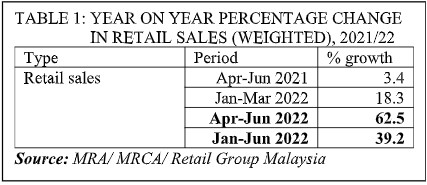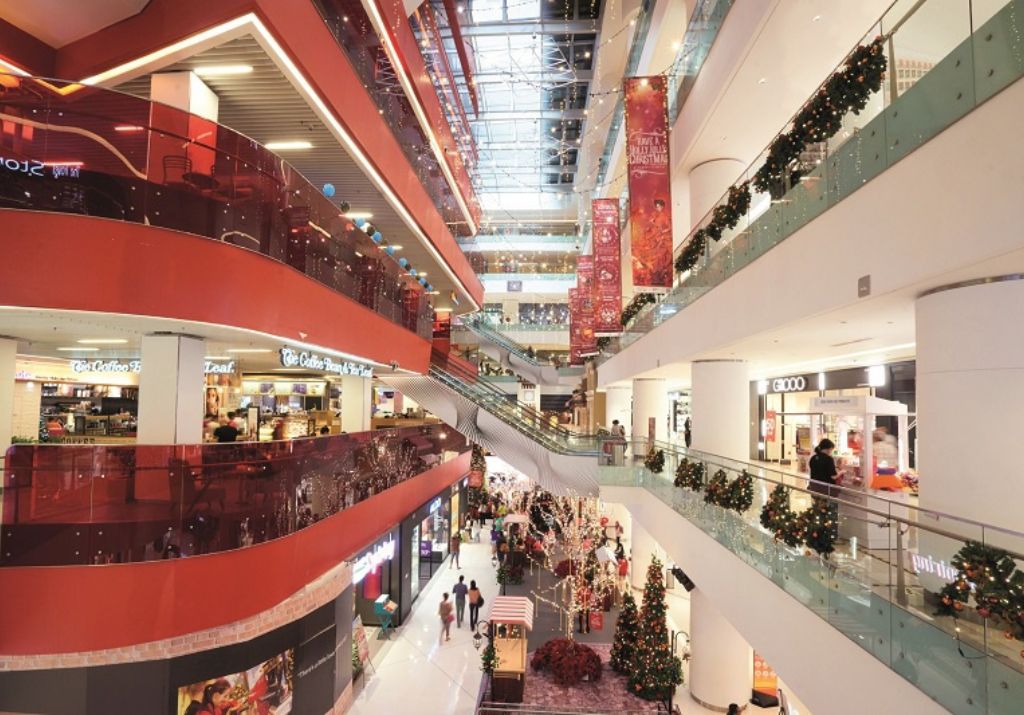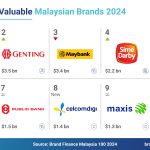Members of Malaysia Retailers Association (MRA) and Malaysia Retail Chain Association (MRCA) were interviewed on their retail sales performances for the second quarter as well as the rest of 2022.
This is the 25th anniversary of Malaysia Retail Industry Report. The first report was published in 1998 during the Asian financial and economic crisis.
LATEST RETAIL PERFORMANCE
For the second quarter of 2022, Malaysia retail industry recorded an all-time high growth rate of 62.5% in retail sales, as compared to the same period in 2021 (Table 1).
This latest quarterly result was far beyond the market expectation. In June 2022, Members of MRA and MRCA estimated an average growth rate of 25.7% for the second quarter of 2022.

This very promising result was attributed to 3 main factors- Hari Raya festival, relaxation of covid-19 SOPs as well as the forced closures of many retail shops in May and June last year.
As for Hari Raya, shopping centres and main commercial centres started to attract large shopping crowd 3 weeks prior to the celebration. While, the peak was a week before Hari Raya. Shopping traffic in major shopping malls stayed at high level even 2 weeks after the holidays.
Also, 2 long weekends’ holidays in May further allowed Malaysians to celebrate fully after 2 years of lockdowns. Retail sales during this period were very encouraging.
During these festivals, major tourist towns and attractions in Kedah, Penang, Perak, Kuala Lumpur, Selangor, Melaka, Johor and Pahang were filled with domestic tourists.
The re-opening of international borders from April 1 had brought cheer to retail businesses that had been dependent on foreign tourists. Border towns located in Perlis, Kelantan and Johor witnessed more foreign visitors entering Malaysia.

The relaxations of many covid-19 SOPs from 1 April 2022 encouraged more Malaysians to return to their usual shopping behaviour and patterns.
A new set of SOPs on retail shops was introduced by the Malaysian government on 1 April 2022. This includes no more restriction of operation hours of retail shops, full capacity for any events or activities with large groups and unboosted Sinovac recipients and senior citizens were allowed to enter shopping centres as well as dine in eateries.
From 1 May 2022, another sets of Covid-19 SOP relaxations were implemented. This time it includes MySejahtera check-in was no longer required, entry into retail premises was allowed regardless of vaccination status except those with ‘High Risk’ status or under Home Surveillance Order (HSO) and physical distancing within retail premises was no longer required.
MCO 3.0 had been re-imposed from 3 May 2021 and ended on 31 May 2021. During this period, majority of retailers suffered from poor sales when Malaysian shoppers avoided enclosed places. Starting from 1 June 2021, Phase 1 of Full Movement Control Order (FMCO) ran for a period of 2 weeks.
During this time, non-essential retailers had been ordered to shut down. Malaysians nationwide were asked to stay at home.
National Recovery Plan (NRP) in 4 phases was implemented from 15 June 2021. Similar to FMCO, non-essential retailers remained close and Malaysian consumers were asked to remain at home.
For the first 6 months of this year, Malaysia retail industry expanded by 39.2%, as compared to the same period a year ago.

COMPARISON OF RETAIL SALES WITH OTHER ECONOMIC INDICATORS
For the second quarter of 2022, Malaysia national economy recorded a growth of 8.9% (Table 2, at constant prices), as compared to 62.5% for retail sales (at current prices).
The services and manufacturing sectors continued to drive the economic growth of the country. During the second quarter, the services sector expanded by 12.0% and the manufacturing sector grew by 9.2%.
The average inflation rate during the second quarter of 2022 rose by 2.8%. Once again, this quarterly increase surpassed the average inflation rate in Malaysia for the last 10 years.
The highest increase was Food & Non-Alcoholic Beverages at 5.1%. All subgroups in this category recorded increases during the quarter.
This category also registered the highest increase since January 2018. The second highest increase was Transport at 4.1%. This was followed closely by Restaurants & Hotels at 4.0%.
Private consumption expanded by 18.3% during the second quarter of 2022. It was driven by higher spending on goods and services, including restaurants, hotels, recreational services and home furnishings.
During the second 3-month period, the Consumer Sentiment Index (by MIER) dipped to 86.0 points. It dropped below the 100-point threshold level of optimism again.
Higher cost of living and weak employment prospect were the main concerns. While, Unemployment rate during the second quarter of 2022 slowed down to 3.9% with improved labour market condition.
RETAIL SUB-SECTORS’ SALES COMPARISON
For the first time since covid-19 pandemic, all retail sub-sectors achieved positive growth rates during the second quarter of 2022.
These latest quarterly results far exceeded market expectation.
The retail sales of Department Store cum Supermarket sub-sector surged by 59.7% during the second quarter of 2022, as compared to the same period a year ago. Similarly, retail business of Department Store sub-sector leaped by 111.3% during second 3-month period of this year.
The Hari Raya festival supported the sales of the Supermarket and Hypermarket sub-sector during the second quarter of 2022.
Its business grew by 7.3% as compared to the same period a year ago and the Mini-Market, Convenience Store & Cooperative had growth rate of 16.7% in retail sales during the second quarter of this year.
During the second quarter of 2022, the Fashion and Fashion Accessories sub-sector had an extraordinary growth rate of 152.8%. A year ago, its business suffered severely from partial and full lockdowns.
The Children and Baby Products sub-sector recorded a big jump in retail business with 65% growth in retail sale during the second 3 months of this year. During the second quarter of this year, Pharmacy sub-sector reported an encouraging growth rate of 31.5%, as compared to the same period a year ago.
At the same time, the Personal Care sub-sector advanced with a growth rate of 79.8% during the second 3-month period of this year and The Furniture & Furnishing, Home Improvement as well as Electrical & Electronics sub-sector had a growth rate of 81.9% during the second quarter of 2022.
The Other Specialty Stores sub-sector (including photo shop, sporting goods’ store, store retailing musical instrument, optical store, store selling health equipment, arts & crafts store as well as direct selling firm) enjoyed a large gain in sales with 91.2% growth rate during the second quarter of 2022.

NEXT 3 MONTHS’ FORECAST
Members of the two retailers’ associations are highly confident of their retail prospect for the next 3 months. They project an average growth rate of 61.7% in retail sales during the third quarter of 2022 (Table 4).
The department store cum supermarket operators are expecting their sales to rise further with a growth rate of 98.9% for the third quarter of this year.
After two impressive consecutive growths, the department store operators are expecting their businesses to expand at a slow pace. Estimated growth rate of this sub-sector is 8.4% for the third 3-month period of this year.
The supermarket and hypermarket operators are expecting their businesses to normalise further in the next 3 months. They expect their businesses to slow down with a -2.6% growth rate for the third quarter of 2022.
In contrast, operators of mini-market, convenience store and cooperative are foreseeing their growth momentum to maintain. For the third 3-month period of this year, their businesses will expand by 17.4%.
Retailers in the fashion and fashion accessories sector expect their businesses to enjoy another round of robust growth at 165.1% during the third quarter of 2022. This is the most optimistic growth projection among the retail sub-sectors.
Retailers selling children and baby products are anticipating their businesses to accelerate further with a growth rate of 132.8% during the third 3 months of this year.
Pharmacy operators are also hopeful of their retail sales during the third quarter of this year with a growth rate of 24.2%.
While, Retailers in the personal care sub-sector are expecting their businesses to swell by 102.2% during the third quarter of 2022.
Operators of furniture & furnishing, home improvement as well as electrical & electronics are upbeat of their businesses in the next 3 months. They project their businesses to expand by 129.5%.
Retailers in other specialty stores sub-sector (including photo shop, sporting goods’ store, store retailing musical instrument, optical store, store selling health equipment, arts & crafts store as well as direct selling firm) are hoping for their business to rise by 53.7% during the next 3-month period.
THE REST OF YEAR 2022
In June this year, Retail Group Malaysia (RGM) estimated 13.1% annual growth rate in retail sales for 2022.
However, there has been a revision considering the fact of the firm recovery of the Malaysia retail industry since beginning of this year.
RGM revises Malaysia retail industry growth rate for 2022 from 13.1% to 31.7% (Table 5) that portrayed the retail industry stepping off the covid-19 wave.

Based on the latest economic developments and Malaysian spending behaviour observed by Retail Group Malaysia, the forecast made by members of the two retailers’ associations (at 61.7%) is considered overly optimistic.
Retail Group Malaysia has revised the third quarter estimate upwards from 3.4% (estimated in June 2022) to 50.0% (as compared to 61.7% estimated by retailers). This higher-than-expected growth rate is due to large contractions during the third quarters of 2020 (-9.7%) and 2021 (-27.8%).
Conversely, the fourth quarter estimate has been revised downwards from 3.6% (estimated in June 2022) to 1.0%. This lower revision is based on the high base a year ago as well as the current challenges of Malaysia retail industry.
Although at a slower rate in recent weeks, prices of retail goods continue to rise. Prices of many foods and consumer goods increased by double-digit within short period of time since beginning of this year. The purchasing power of majority of Malaysian consumers have been affected.
For many retail outlets, the lack of staff whether locals or foreign workers, has affected their sales and operation hours that took a toll on retail supply chain.
Since the re-opening of international border on 1 April 2022, Malaysia had attracted more than 2 million foreign visitors as at June 2022.
The latest target by Ministry of Tourism, Arts & Culture is to achieve 4.5 million foreign tourist arrival by end of this year. However, this is still way below the foreign tourist arrival in 2019 at 26.1 million.
FOOD & BEVERAGE SECTOR
Hari Raya festival contributed to higher sales for F&B outlets in all parts of the country. Family and social gatherings during this period boosted dine-in sales for cafes and restaurants.
Night entertainment outlets had been allowed to re-open from May 15 after more than 2 years of closures.
Higher food prices and higher minimum wage had led to increased operation costs for F&B operators in Malaysia.
Many F&B outlets (including hawker stalls, coffee shops, cafes, restaurants and national chain outlets) located throughout the country had raised their retail prices.
Food & Beverage Outlets (Cafe and Restaurant) recorded an upbeat growth rate of 36.3% during the second quarter of 2022, as compared to the same quarter a year ago (Table 6).

Similarly, the sales of Food & Beverage Outlets (Take-Away, Kiosk and Stall) climbed by 35.5% during the second quarter of 2022, as compared to the same period one year ago.
F&B operators are still struggling with higher raw material costs and depleting profit margin during the third quarter of 2022 as well as shortage of kitchen staff and servers.
Cafe and restaurant operators are foreseeing their businesses to expand further for the third 3 months of this year. They expect their food businesses to grow by 42.6% as compared to the same period last year.
In addition, food and beverage kiosk and stall operators are anticipating their businesses to grow by 24.6% during the third quarter of 2022.
MARKETING Magazine is not responsible for the content of external sites.
After 20 years of evolving technology, shifting market trends, and adapting to changing consumer behaviour, the media landscape has nearly reached saturation.
We’ve optimised to the fullest, providing advertisers with abundant choices across technology, platforms, data-driven marketing, CTV, OTT, DOOH, influencer marketing, retail, etc.
Media specialists have diversified, but with more options comes the challenge of maintaining income growth. The industry is expanding, but revenue isn’t keeping pace.
Now, we’re at a TURNING POINT: time to explore and harness new sustainable revenue streams. While GroupM forecasts a 7.8% global ad revenue growth in 2024, challenges like antitrust regulation, AI and copyright issues, and platform bans persist.
Collaboration is key: partnerships that thrive on synergy, shared values, and aligned goals are becoming increasingly essential.
Hence, the Malaysian Media Conference, in its 20th year, has assembled the partners and players under one roof on October 25 for a day of learning, sharing, and exploring.
REGISTER NOW










